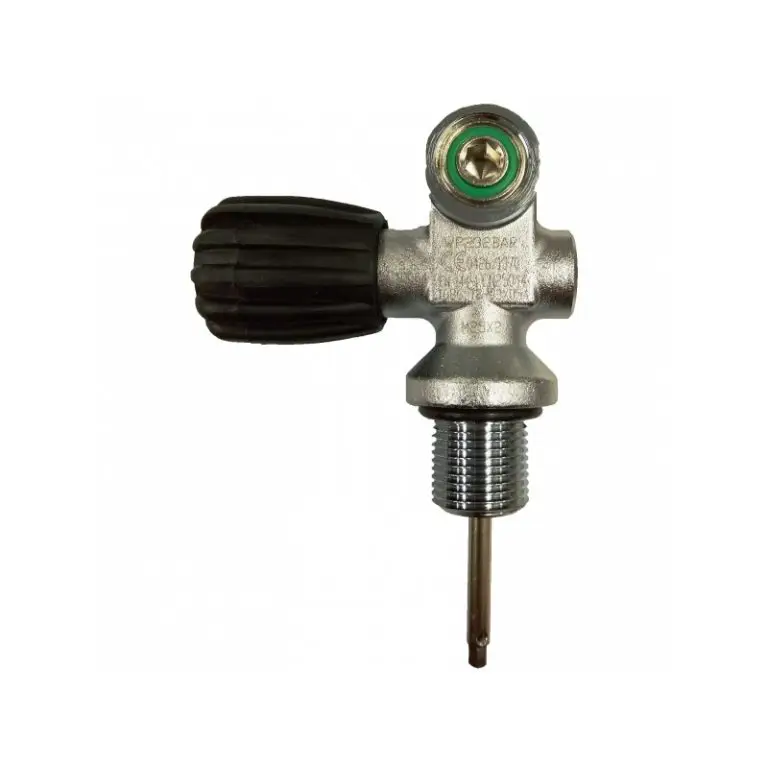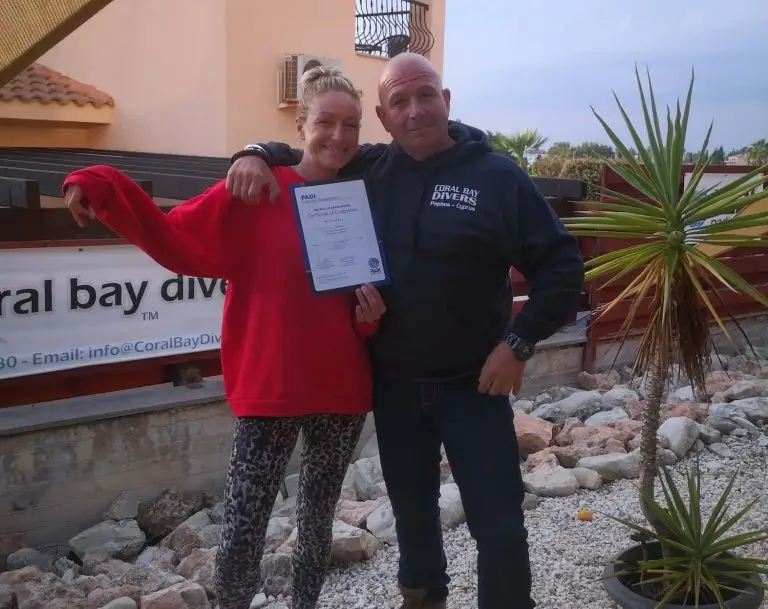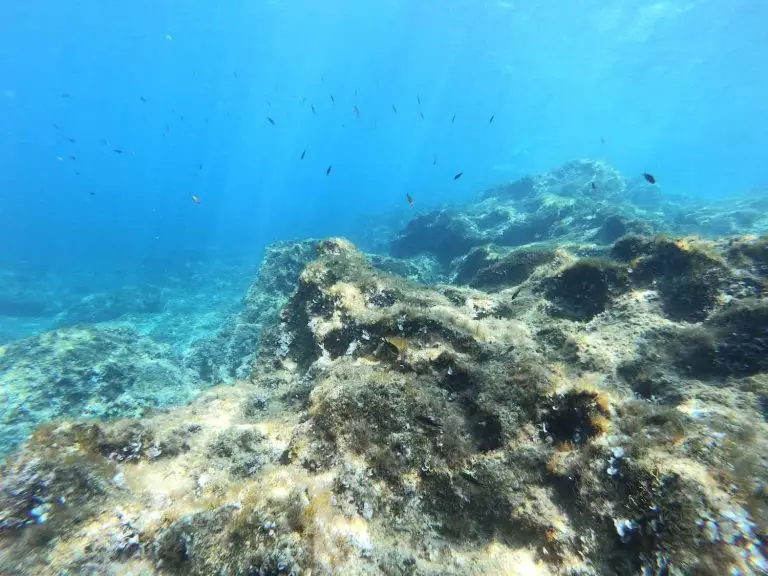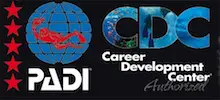Can I scuba dive without taking a full scuba diving training course?
Yes, you can dive without taking a diver training course, this is what the DSD experience is for. Of course, you will have to learn the basic skills to keep you safe, but your first scuba diving experience will be a magical one.
My Discover Scuba Diving experience with Coral Bay Divers
Coral Bay Divers offer a warm welcome that puts you at ease the second you walk through the door. A friendly smile and relaxing environment. Surrounded by quality dive equipment and pride in the business, that I learned, they had built over almost 20 years.
Jurg Dahler, the dive centre owner and Course Director (CD), is the most qualified diver on the island of Cyprus. He greets me with a smile and a friendly welcome. I’m lead through the shop that has interesting scuba diving gear hanging in a wonderous display, to the open and inviting garden terrace at the back of the shop. A place you can see yourself spending many a day, learning how to scuba dive and mixing with dive experts and an instructor team that clearly love being there.
We sit in the sheltered sunlight, with a coffee, and go through the necessary forms to ensure you understand the requirements of your first diving experience.
I had done a bit of research before signing up for my DSD. I’d like to share a bit of that as I found it helpful to know what to expect before I started.
PADI’s Four E Philosophy
PADI is the Professional Association of Diving Instructors. PADI’s 4 E philosophy on learning to dive requires you to understand and be mindful of four key elements:
- Education
- Equipment
- Environment
- Experience.
Coral Bay Divers is a 5 Star rated PADI Career Development Centre on the island of Cyprus.
Education – what you need to learn to become a diver
Continual learning is the key to becoming a good diver. There are a number of courses you can take after your DSD, I have signposted these for you at the bottom of this blog.
For the DSD we learn the basics.
- How do I breathe underwater?
- How do I communicate underwater?
- How do I stay (neutrally) buoyant?
- What equipment do I need to dive?
Once your paperwork is completed, you go through the scuba diving basics, from the science behind the way water and air pressure relate, to the scuba diving equipment that you will be using. The explanation is accompanied by a book that contains the information in words and pictures to help explain the effects of air in the body when under water. You will learn how to equalize the air space, a simple but crucial technique, you will learn hand signals to help you communicate underwater and the theory behind staying neutrally buoyant.
Equipment – the diving gear you’ll need to go diving
You will talk through how to dive safely using the equipment involved in your first dive:
- Your wetsuit and footwear
- Your weight belt
- Your mask, how to wear it and how to clear it when it has a little water inside (don’t worry – this is normal)
- The purpose and operation of your BCD (Buoyancy Control Device), how to pressurise and de-pressurise to keep you buoyant
- Your regulator, this is the mouthpiece and hoses that is connected to your gas cylinder
- Your gas tank and pressure gauge
You are reassured that this will all be demonstrated with each piece of equipment at the next stage of learning.
Once you have completed a short quiz about the information you have learned you move over to the equipment. You will be introduced to your scuba diving wetsuit, your BCD (Buoyancy Control Device), gas tank, regulator, pressure gauge, mask, snorkel and fins.
The easiest way to put on a wetsuit
Then the fun part; squeezing into a wetsuit. It is tricky when you first do it, but it does get easier. My best advice would be to get the suit over your feet and pull it up your ankles a bit before pulling it to your knees – it is not like pulling on a pair of trouser, more like a gradual staged wiggle; you will understand this better if you’ve ever put on a pair of tights. Straighten your suit out up to the knee, then up to the thigh and make sure its sitting comfortable on your waist before you attempt to put your arms in. Again, pull it over your hands and up your wrists so that you have plenty of suit to pull up your arms. I’m telling you this because it’s not something that is explained but learned experience. Your dive buddy will zip you up, it’s much easier that way. Everything else you put on when you get to the confined water dive site.
Environment – the landscapes, depths, and skills you learn to preserve the natural world
There are so many different diving environments. Shallow water, deep water, dive sites with rocks, valleys, grassland and rock formations that you can swim through. Wreck dives and sunken treasures all around the world in different temperatures and tidal situations. Not to mention an abundance of sea-life, and it is important to protect it as much as possible.
When you become a more advanced diver you will learn a lot about how to navigate in different situation and learn about wildlife and habitats. For your DSD you will start by learning to be a buoyant observer, starting in confined water with the opportunity a swim out into deeper water, within your comfort zone.
Confined water diving on your DSD experience
You start in shallow water and go through all of the safety information that you learned in your briefing. Your BCD will be fully inflated, so at this stage it’s like wearing a life jacket, and you will be buoyant whilst you go through the in-water learning.
You will take your first breath under water, this is something you will never forget, it is a truly liberating experience. Here you will learn all of the basic skills to start your life as a scuba diver.
Once you have shown that you have the basic skills and are comfortable in the water you will descend, deflating your BCD. You will practice a few under water skills and then you can start to explore with your instructor and dive buddies by your side.
Experience – getting used to your dive kit, how to manage your dives, knowing what do to when different situations arise when diving
When you go beyond your initial dive there a lot of things to learn and experience. Like anything, the more you dive, the better you will be at diving. The first real skill to master is buoyancy control.
Buoyancy control on your DSD experience
Buoyancy control is something you will learn over time. Your aim is to be neutrally buoyant, meaning that you don’t touch the bottom and don’t float to the top. You do this by adding air into your BCD as you descend (or go deeper) and by letting air out as you ascend (or get closer to the surface). You will probably rest on the bottom a few times or find yourself floating upwards toward the surface. When this happens just try and relax. This is normal and you will learn to control it. Your instructor is at your side at all times and will help you to control this until you get the hang of it.
On your discover scuba diving experience you will have a slow gradual decent and ascent along the sea bottom. This helps you get used to the change in pressure and the amount of air to you need to add and remove from your BCD.
Open water diving on your Discover Scuba Diving experience
Swimming out from the shore for this first time will be exhilarating. You will be guided out at a steady pace and only go as deep as you feel comfortable (within the confines of the depth allowed at this level of experience). You will be very aware of everything around you. The sound of your bubbles leaving your regulator as you exhale, the movement of the sand on the seabed. The light streaming through the water from the surface and the patterns it makes.
Meeting fish for the first time, face to face in their own environment is something of real beauty. You will never understand the feeling until you do it or be able to explain the feeling of your first dive to anyone. Everyone should you have a try dive and experience it for themselves.
I always say to people, once you’ve been under the water you realise just how much more of this planet there is to explore. The underwater world is as incredible as what can be found above water. When you swim over the edge of a rock face, I believe it’s the closest thing to flying that you can experience. It’s just incredible.
Just remember to relax, breath and enjoy. You’re in safe hands.
Scuba diving training courses and e-learning
If you want to find out about how you can progress from DSD there are a number of options available, from PADI Open Water Courses all the way up to PADI Instructor Development Courses.
You can view details on each course from the following list of areas:
- Snorkelling and novice scuba diving experiences
- Beginners’ scuba diving courses
- Advanced scuba diver and Speciality Diver Courses
- Technical Diving Courses
- Professional Scuba Diving Courses
Coral Bay Divers also offer PADI e-learning programmes. This means that you can complete a lot of the theory and learning online before coming out to dive, saving you time and money on your trip.
What are you waiting for? Book a dive now!






